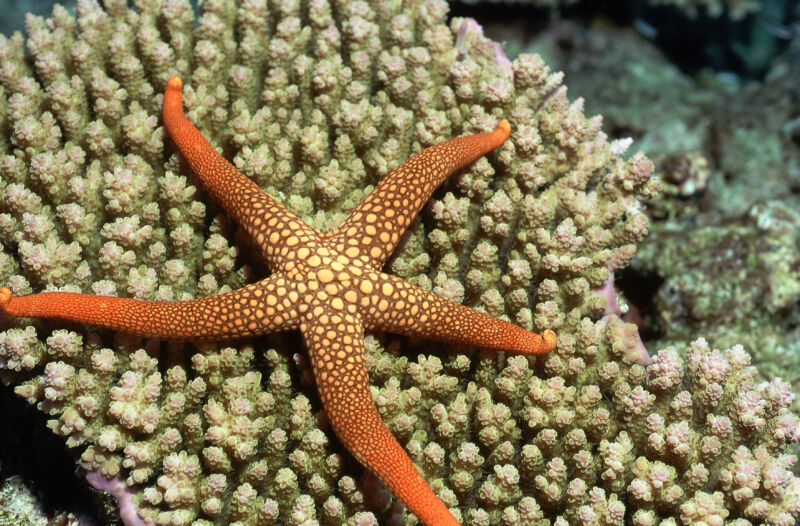
For many creatures, getting a limb stuck in a predator’s mouth is usually a death sentence. Not so for starfish: they can detach the limb and give the predator something to chew on while they crawl away. But how do they do it?
Starfish and some other animals (including lizards and salamanders) are capable of autonomy (shedding a limb when attacked). The biology behind this phenomenon in starfish has been largely unknown until now. An international team of researchers led by Maurice Elphick, Professor of Animal Physiology and Neuroscience at Queen Mary University of London, has discovered that a neurohormone released by starfish is largely responsible for releasing limbs caught in the jaws of a predator.
How does this neurohormone (specifically a neuropeptide) allow the starfish to escape? When a starfish is stressed by a predator, this hormone is secreted, which stimulates a muscle at the base of the animal's arm, causing the arm to break off.
The researchers confirmed that this neuropeptide “acts as an autotomy-promoting factor in starfish, making it the first neuropeptide identified as a regulator of autotomy in animals,” they said in a study recently published in Current Biology.
To cling
Elphick's team investigated how the neuropeptide known as ArSK/CCK1 facilitates autonomy in the European starfish, Asteria rubensIt is already known that ArSK/CCK1 inhibits eating behavior in A. Rubens by causing the stomach to contract, and muscle contraction plays a role in limb loss. The researchers found that the ability to cause contractions goes beyond eating.
Starfish were subjected to an experiment that simulated conditions where a predator's jaw clamped onto one arm. Clamps were placed on one of three sections on one arm, either at the tip, the middle, or at the spot at the base where autotomy is known to occur, known as the autotomy plane. The starfish were then suspended with these clamps above a glass bowl of seawater. During the first part of the experiment, the starfish were allowed to respond naturally, but during the second part, they were injected with ArSK/CCK1.
Without the injection, autotomy was seen primarily in animals with arms clamped closest to the autotomy plane. There was not nearly as much response from starfish when arms were clamped in the middle or at the tip.
In the second half of the experiment, the clamping used previously was combined with an injection of ArSK/CCK1. For comparison, some were injected with the related neuropeptide ArSK/CCK2. An astonishing 85 percent of the ArSK/CCK1-injected animals that were clamped in the middle of the arm or closer to the autotomy plane showed autonomy, and some autotomized additional arms. This occurred in only about 27 percent of those injected with ArSK/CCK2.
Letting go
Although ArSK/CCK1 was found to be the most effective chemical trigger for autotomy, its activity at the autotomy plane depends on certain aspects of the starfish anatomy.
Like all echinoderms, starfish have endoskeletons made up of small bones, or ossicles, connected by muscle and collagen fibers, which allow the animals to change position and move. Two unique features found only in the autotomy plane allow this structure to break. Under the skin of the autotomy plane is an area where bundles of collagen fibers are widely spaced to facilitate breaking. The second feature is a band of muscle close to the area of collagen bundles. This muscle, known as the tourniquet muscle, is responsible for the constriction that can cause an arm in danger to fall off.
By analyzing the arm tissue of a starfish while it was undergoing autotomy, the scientists gained a new perspective on this process. Immediately after a predator grabs a starfish’s arm, ArSK/CCK1 tells the nerves in the tourniquet muscle to begin contracting in the area near the autonomic plane. As this happens, the collagen in the body wall in that area softens and breaks, as do the muscles and ligaments that hold the ossicles together. It is now thought that ArSK/CCK1 is also involved in softening this tissue, preparing it for rupture.
After starfish autotomize a limb, that limb eventually regenerates. The same happens in other animals that can use autotomy to their advantage (such as lizards, which also regrow their tails). In the future, discovering why some animals have the ability to regenerate may tell us why we never evolved it, or why some of our ancestors lost the ability. Elphick acknowledged that there may be other unidentified factors that work in concert with ArSK/CCK1, but further insight could one day give us a clearer picture of this process.
“Autotomy is an important survival adaptation that has evolved in several animal species,” the research team said in the same study.[and] The findings of this study provide groundbreaking insight into the neural mechanisms that control this remarkable biological process,”
Current Biology, 2024. DOI: 10.1016/j.cub.2024.08.003

